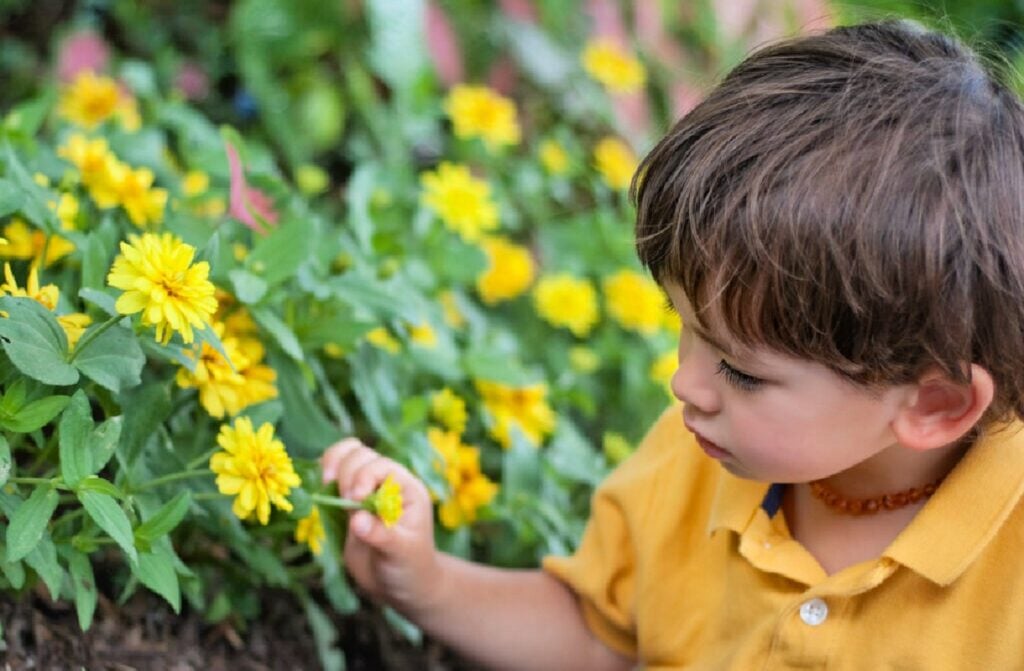5 Simple Ways to Encourage Mindfulness in Children
When we encourage mindfulness in children, are we actually teaching them something new? Or are we just trying to preserve the inherent consciousness they were born with? In other words – is mindfulness taught, or is it something that was there but has just been “unlearned” over time?
Dr. Monisha Vasa, psychiatrist, mother, narrative medicine scholar, and mindfulness practitioner, shares her advice on encouraging mindfulness with your child.

I remember watching my son eat when he was five years old. If given a cookie, he would turn it delicately over and over in his hands. He would study the texture and composition with his eyes. He might inhale the chocolatey scent.
All before taking a single bite.
And when he started to eat, he would savor each mouthful, thoroughly enjoying himself. And the most amazing thing… when he’d had enough, he would put the cookie down and move on, not feeling compelled to continue eating if he was no longer hungry.
Children Are Inherently Mindful
I find that young children often already have the inherent knowledge of how to live mindfully. It’s often simply what they do without knowing any differently. They linger on their walks, observing the flowers, turning over rocks, running when their bodies feel like accelerating, spinning around when their hearts feel like turning.
But these days, when I take them on walks, I am aware of the homework that needs to be completed, or bedtime looming. I urge them to hurry. I start to accelerate in my head. If we don’t get back home in time, we won’t finish dinner and homework in time.
If dinner and homework don’t get done, bedtime will be delayed. If we miss our window of opportunity for bedtime, they won’t fall asleep. If they don’t fall asleep, they won’t wake up in time for school. If we’re late for school, I’ll be late for work…
And so on and until I’m spinning into the catastrophic implications for the next day, rather than being present for the walk that we are on in the here and now. With the tension in my body and my rushed voice, I put a screeching halt to searching for roly-polys and blowing the dandelions.
Of course, we have to balance our mindfulness practices with the logistical needs of day to day life. But I realize I often start to fall into a pattern of hurrying them when hurrying isn’t necessary, rushing them when we have time. Part of this frantic pace is because our kids are often over-scheduled or over-committed. Part of this rushing comes from feeling frazzled ourselves, and projecting that onto our kids.
What is Mindfulness?
Simply put, mindfulness means paying full attention to something while not thinking about anything else in this moment. Being mindful is the opposite of multitasking.
When children and teens focus on being mindful, they slow down, take their time, and focus on something in a way that is both relaxing and stress-free. A mindfulness meditation usually involves some combination of breathing exercises, visualization, body awareness, and relaxation.
Mindfulness has been found to increase a child or teen’s ability to regulate emotions as well as feel compassion and empathy. It also is widely considered an effective treatment for people of all ages that deal with aggression, ADHD, or other mental health problems like anxiety. And can even be used to alleviate the painful effects of bullying.
Mindfulness also can be used as a tool to enhance self-concept, improve planning skills, and control impulses. And, when used effectively in schools, mindfulness can reduce the number of visits to the principal’s office, decrease the amount of school bullying, and improve attendance. (source)
5 Ways to Encourage Mindfulness in Your Child
These days, my goal isn’t necessarily to teach my kids how to be mindful. My goal is to get myself out of their way. I try to allow them time to play.
To explore. And to rest. To breathe. And to just be.
It’s not easy as they get older, and they are pulled in multiple directions, as are we. It often feels like we are juggling a million balls in the air at once and they are all about to come crashing down. But we try our best to honor the time and space for them to just be who they are, because that is when we find their most centered selves emerging. Or perhaps that is when we are most able to notice.
1. Allow for plenty of unscheduled down time
Kids may complain of getting bored, or you may see them get restless. It is important for children to have enough simplified downtime to become aware of these emotional states and see them through on their own.
Consider refraining from stepping in with solutions or ideas. This process helps them to learn that they can sit with all sorts of emotions, and that emotional states come and go. Often periods of intense creativity arise from boredom and quiet.
2. Model mindfulness
Make time for your own mindfulness practice. Whether you have a formal sitting practice or try to implement conscious awareness throughout your day, make it a priority. Kids will do what they see us do, more than they will listen to what we say.
Use your practice as a springboard to discuss setting intentions, or cultivating gratitude for the small and big blessings of our lives: “I am grateful for the fact that we are all able to sit down together for dinner today.”
3. Ask lots of questions
Ask questions that encourage children to connect to their senses. “What does the air after today’s storm smell like to you?” or “What do you see in the clouds today?”
Using our senses or awareness of our breathing is a way to connect immediately to the present moment. We can also ask our kids questions to consider other people’s feelings, or their impact on others. For example, “There was a new boy in class today? What do you think that was like for him?”
4. Manage your expectations
Kids may not always be in the mood to discuss big picture ideas like gratitude and compassion. Use kid friendly language and consider bringing up such topics in casual passing, or at night before bed when they are relaxed.
Some kids may be open to guided meditation practices. It is ok to be brief, or to let it go if they are not receptive in a given moment. We are just planting seeds. Even the introduction of mindfulness to their developing minds can be helpful.
5. Discover opportunities for compassion
Mindfulness ultimately is one tool to recognize our interdependence, and find ways to relate to one another with an open heart. Discover opportunities for kindness and compassion within your family, and in the larger community. This could mean involving children in a simple service project, or making it a point to use positive, kind language with those we come across.
One of the beauties of the process of teaching mindfulness in children is that it is a journey for child and parent alike. Teacher becomes student becomes teacher, as we together deepen the process of occupying our bodies and living our lives as they unfold before us.
There are no mistakes, no right ways or wrong ways, just the ways that work for each family. Let us encourage our children, just as they encourage us, to cultivate a more curious and fully lived life. The process itself is a gift and a blessing for all of us.
More Ways to Encourage Mindfulness With Kids
Each day is filled with moments for us to slow down and be aware of our present situation. These articles offer ideas and ways to continually show up in a mindful way.
Mindful Sleep Routines
Mindfulness Activities for Teens
Outdoor Mindful Art Activities
Guided Meditation and Printable Mindful Cabin Scene
Nervous System Regulation for Kids and Parents|
How Meditation Can Make You a Better Parent
Mindful Toys and Gift Ideas for Kids
Gifts for Kids Who Do Yoga
Meditation Toys for Kids
Educational and Mindful Resources for Kids
Create a Calm Down Corner at Home

